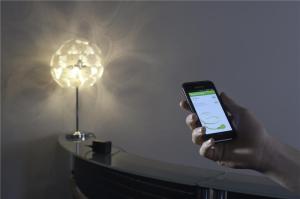A separate IP address is assigned to each power outlet
Many homeowners dream of being able to wash a load of laundry when the photovoltaic panels on the roof are delivering a maximum of electricity, even when they are not at home. A new Internet-enabled power outlet will soon allow users to control household appliances via their smartphone, and reduce their energy costs into the bargain.
Soon there will be no need for special timers to switch lighting on and off or operate household appliances when the homeowner is absent. In future, all this can be done by means of a smartphone or PC, thanks to Internet-enabled wireless power outlets that support the new IPv6 Internet protocol. The smart socket was developed by researchers at the Fraunhofer Institute for Communication Systems ESK in Munich in collaboration with the Fraunhofer Institute for Industrial Mathematics ITWM in Kaiserslautern and the industrial partner embedded brains GmbH. “We have been able to connect the power outlets wirelessly using the IPv6 protocol,” says ESK research engineer Günter Hildebrandt. “All household appliances plugged in one of the sockets can be switched on and off remotely using an IPv6-compatible device such as a smartphone or laptop PC – from anywhere.”
The wireless power outlets are a component of the HexaBus home automation system that was developed by the ITWM as part of the mySmartGrid project (www.mysmartgrid.de). “The HexaBus components make the smart home of the future a reality. They enable household appliances to be controlled intelligently, thus optimizing or reducing electricity consumption. For example, the householder can start the washing machine during cheap-rate off-peak hours, or run the dishwasher when the photovoltaic panels on the roof are generating sufficient power,” says industrial engineer Mathias Dalheimer of the ITWM, who leads the SmartGrid project and is its chief programmer.
Intelligent control and measurement of power consumption
In addition to the wireless power outlets, the HexaBus system employs a specially designed USB stick that plugs into any compatible, off-the-shelf router. The user enters the command to switch on an appliance via a standard web browser or an Android-compatible smartphone app. The router and stick then forward the data to the power outlet. This two-way communication function also allows the wireless power outlet to send data to the smartphone, informing the user how much power various appliances are consuming at any given time. Thus, the user can optimize their power consumption. “The combination of parallel control and measurement functions is an entirely novel feature that no other wireless power outlet has offered before,” says Hildebrandt.
Because the HexaBus system is based on the IPv6 data communication protocol, a separate IP address is assigned to each power outlet, and thereby to each connected appliance, enabling them to be accessed directly. But how did the researchers go about integrating Internet functionality in the wireless power outlets and USB sticks? To do so, Hildebrandt and his team developed special protocol software and an extension to the Contiki operating system that enables it to handle the 6LoWpan (IPv6 over Low power Wireless Personal Area Network) communication protocol. Contiki is an open-source operating system for networked embedded devices such as the microcontrollers incorporated in wireless power outlets and USB sticks. A linked web browser protocol enables users to assign a separate name to each power outlet – such as “washingmachine.basement”.
via Fraunhofer
The Latest Streaming News: Smart wireless power outlets updated minute-by-minute
Bookmark this page and come back often
Latest NEWS
Latest VIDEO








